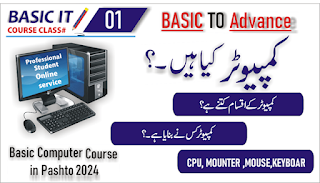With the rapid advancement of technology, an in-depth understanding of computers has become essential in virtually every field. Computer II offers learners the opportunity to build upon foundational knowledge acquired in introductory courses. This blog post will provide an overview of the key components and concepts covered in Class 01 of Computer II, setting the stage for a more comprehensive exploration of computer systems and their applications.
What is Computer ?
Computer is typically a continuation of Computer I, aimed at expanding students' knowledge of computer architecture, programming concepts, and systems integration. While Computer I often focuses on basic operations and introductory programming, Computer II delves deeper into theoretical and practical aspects of computing. This course is designed for students with a fundamental grasp of computer principles, and it builds upon that knowledge to tackle more complex topics.
Review of Basic Computer
Understanding the parts of a computer is critical before moving forward. Class 01 typically begins with a refresher on the components of a computer system, including:
- **Central Processing Unit (CPU)**: Often referred to as the brain of the computer, the CPU performs computations and executes instructions.
- **Memory and Storage**: This section covers the distinction between volatile (RAM) and non-volatile (hard drives, SSDs) storage, highlighting how data is temporarily or permanently stored.
- **Input and Output Devices**: Students learn about various peripherals that allow users to interact with the computer, such as keyboards, mice, printers, and monitors.
Software Fundamentals
This part of Class 01 introduces students to the distinction between system software and application software. Understanding this separation is key to later discussions on operating systems and application design.
- **Operating Systems**: Students receive an overview of popular operating systems and their functionalities, including Windows, macOS, and Linux.
- **Application Software**: A discussion on various applications, ranging from word processors to complex databases, emphasizes the diverse uses of computers in different domains.
Introduction to Programming Concepts
Programming serves as a backbone for many operations within a computer system. Class 01 lays the groundwork by introducing:
- **Programming Languages**: A brief overview of different programming languages (e.g., Python, Java, C++), their applications, and paradigms.
- **Basic Algorithms**: Students learn fundamental algorithms and data structures that are essential for solving problems programmatically.
Networking Basics
Understanding how computers communicate is vital, especially in a world that is increasingly interconnected. This section covers:
- **Network Types**: Introduction to local area networks (LANs) and wide area networks (WANs).
- **The Internet**: An overview of how the internet works, including concepts like IP addresses, DNS, and the importance of cybersecurity.
Principles of System Integration
The final segment of Class 01 examines how different components of a computer system work together. This discussion includes:
- **Interfacing**: How various hardware and software components interact and communicate efficiently.
- **Troubleshooting**: Basic strategies for identifying and resolving issues within a computer system.
Conclusion
Class 01 of Computer sets the foundation for a deeper understanding of computer science by revisiting fundamental concepts and introducing new topics that are integral to the study of computers. As students progress through the course, they will develop the skills necessary to navigate more complex systems, engage in programming, and appreciate the intricacies of networked environments. This initial class not only prepares students for the challenges ahead but also instills a sense of confidence as they explore the ever-evolving world of technology.


Post a Comment